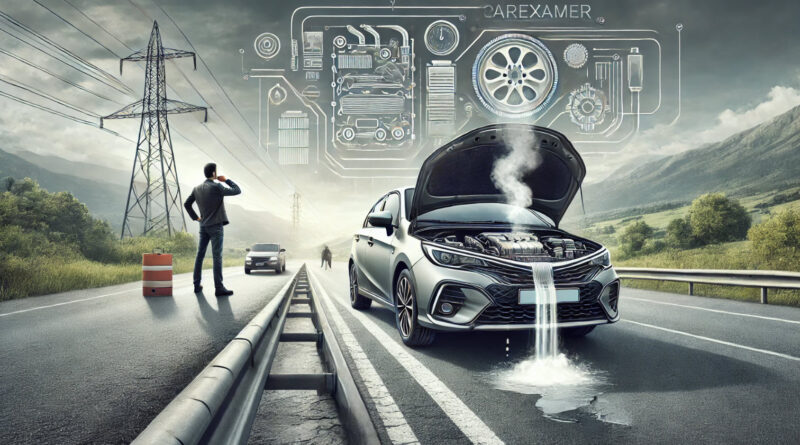A Guide What to Do If Your Car Is Overheating
This guide will walk you through the steps you should take if your car begins to overheat, helping you manage the situation effectively. An overheating car can be a stressful and potentially dangerous situation. It’s crucial to act quickly and safely to prevent damage to your engine and avoid being stranded on the road.
1. Recognize the Signs of Overheating
The first step in dealing with an overheating car is recognizing the warning signs. Here’s what to look out for:
- Temperature Gauge: If your car’s temperature gauge moves into the red zone or the “H” (Hot) indicator lights up, your engine is overheating.
- Steam or Smoke: If you see steam or smoke coming from under the hood, this is a clear sign that your engine is overheating.
- Strange Smells: A sweet smell might indicate leaking coolant, while a burning smell could suggest oil or other fluids are overheating.
2. Turn Off the Air Conditioning and Turn On the Heater
If you notice your car is overheating, immediately turn off the air conditioning to reduce the strain on your engine. Then, turn on the heater to its highest setting. This may seem counterintuitive, especially on a hot day, but it helps to draw heat away from the engine into the car’s cabin, potentially reducing the engine’s temperature.
3. Pull Over Safely
As soon as it’s safe to do so, pull over to the side of the road. Turn off the engine to prevent further damage. If possible, find a shaded area to park your car, as this will help the engine cool down faster.
4. Let the Engine Cool
Do not attempt to open the hood immediately after pulling over, as the engine and its components will be extremely hot. Wait at least 15-20 minutes for the engine to cool down. Opening the hood too soon could result in burns from hot steam or fluids. You can turn heater to hot and turned heater blower on full speed to cool down the cooling system this would only work if you haven’t lost coolant it will help lower the pressure on cooling system turn engine over after several min and turn it off repeat.
5. Check the Coolant Level
Once the engine has cooled, carefully open the hood and check the coolant level in the radiator or coolant reservoir. If the coolant level is low or empty, this could be the cause of the overheating.
- Topping Up Coolant: If you have coolant or antifreeze on hand, top up the reservoir. If you don’t have coolant, use water as a temporary solution, but be sure to replace it with proper coolant as soon as possible.
6. Inspect for Leaks
After topping up the coolant, inspect the area under your car for any visible leaks. Look for puddles of coolant or any signs of fluid dripping from the engine. If you find a leak, it’s essential to have your car inspected by a mechanic as soon as possible, as driving with a coolant leak can cause severe engine damage.
7. Restart the Engine
Once you’ve topped up the coolant and allowed the engine to cool, restart the engine and monitor the temperature gauge closely. If the temperature remains in the normal range, you may be able to continue driving, but it’s advisable to head straight to a mechanic for a thorough inspection.
8. Call for Roadside Assistance if Needed
If your car continues to overheat after taking these steps, or if you’re unsure of what to do, it’s best to call for roadside assistance. Driving an overheating car can cause significant damage to the engine, leading to costly repairs.
9. Prevent Future Overheating
To prevent future overheating, it’s essential to keep up with regular maintenance. Here are some tips:
- Regularly Check Coolant Levels: Make sure your coolant levels are always topped up, and check for leaks regularly.
- Inspect Belts and Hoses: Worn or damaged belts and hoses can lead to overheating. Inspect them regularly and replace them if necessary.
- Ensure Proper Radiator Function: Keep your radiator clean and ensure the cooling fan is working properly.
Practical Tips:
- If you noticed your car is overheating only in traffic and you know your coolant fan don’t work turn heater on hot and heater fan on full speed watch if temperature goes down this will get you home. (will only work if thermostat is operational and not stuck closed). When you drive at constant speed above 30mph air passing through radiator will cool your engine if the fan is not working.
An overheating car is a serious issue that requires immediate attention. By following these steps, you can safely manage the situation and prevent further damage to your engine. Regular maintenance and being mindful of your car’s cooling system can help you avoid the stress and potential dangers of an overheating vehicle in the future. Remember, if you’re ever in doubt about what to do, it’s always best to seek professional assistance to ensure your safety and the health of your car.
Buying a used VW. Buying used vauxhall, BMW, Jaguar, Ford, Volvo, Range rover, Bentley, Aston Martin, Porsche, Ferrari, Lamborghini, Maserati, Hyundai, Tesla, Honda, Pagani

